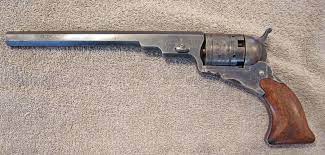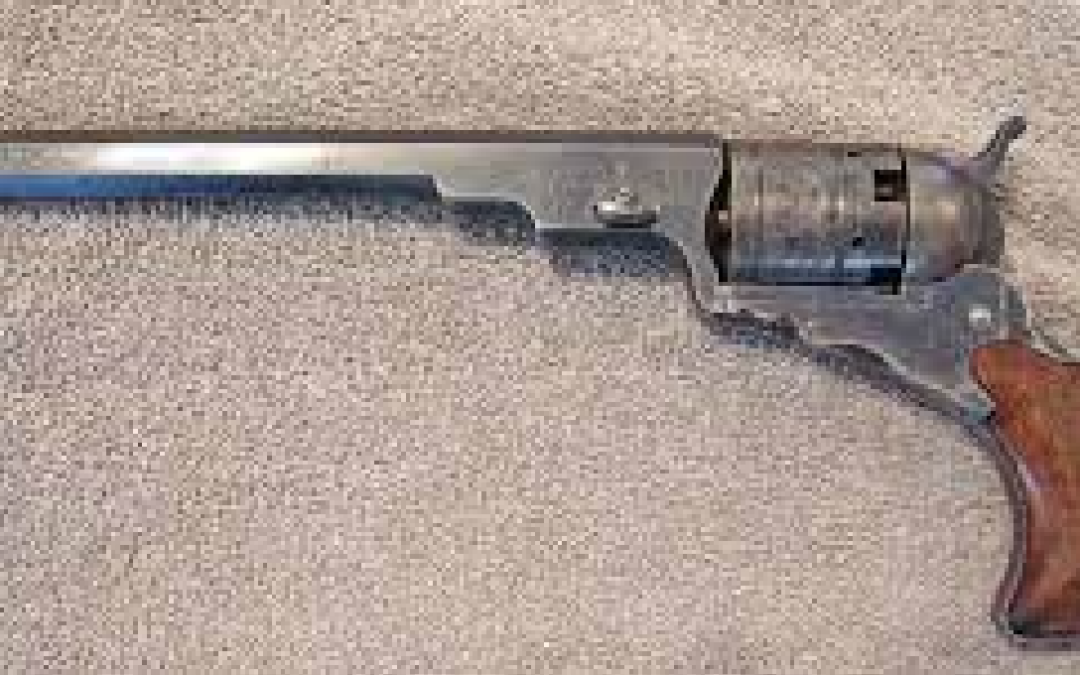
In the years before the 1840’s the favorite side arm was a knife, and the big guy with long arms had a distinct advantage. Before the coming of the revolver and repeating rifle the Indians boasted superior firepower with bows and arrows. A warrior could unleash 12 to 15 arrows in the time it took to reload those single-shot muzzleloaders and they cleverly timed their attacks accordingly. But Sam Colt’s new revolving pistol made all men equal. He got the idea for a revolving cylinder while traveling on board a sailing ship. He noticed the pilots wheel spokes always returned in perfect line with a clutch that locked the wheels in position with any spoke that was in line with it. Applying this principle to a revolving pistol, the cylinder would bring the chambers in line with the hammer and barrel through which they would be discharged. He patented the new invention in England in 1835.
Military intelligence (an oxymoron?) was still living in the 16th century when it came to rapid-fire weapons. The brass hats didn’t believe common soldiers were intelligent enough to shoot anything more complicated than a single-shot muzzleloader and weren’t interested in the newfangled contraption. Finding buyers wasn’t easy but Colt did sell a few to the Texas Navy in 1839. Some of these found their way into the hands of the Texas Rangers, who were waging war against the formidable Comanche and Kiowa warriors.
The first Colts, produced between 1836 and 1841 were the .36 caliber Paterson model “belt” or “holster” revolvers. The caliber ranged from .28 to .36 and were manufactured at Colt’s plant in Patterson, New Jersey. They came in barrel lengths ranging from 4 to 12 inches but the 7 1/2 and 9-inch were the most popular. They were fragile and fired only five rounds. Still, they proved to be effective in warfare against the Indians.
In 1844, the Colt’s revolver carved its niche in Texas history. Texas Ranger Captain, John Coffee Hays and fifteen Rangers stood off eighty Comanches at the Pedernales River, killing forty-two while losing only two wounded.
One of the wounded was a man named Sam Walker. Walker, who later became a lieutenant colonel in the Rangers, wrote Colt praising the revolver mentioning that the Rangers “confidence in them is so unbounded, so much so that they are willing to engage four times their number.”
Not long after the battle on the Pedernales, Captain Hays and his small force of Rangers encountered another large force of Comanches. The Rangers fired their rifles, then jumped into their saddles. Captain Hays yelled “Charge” and the tiny band of men rode right into the middle of the surprised warriors firing their pistols and generally raising hell. The Comanche were used to the Texans getting into defensive positions and were unprepared for the charge. “Powder-burn them!” Hays shouted as they raced through the Comanche ranks. The warriors tried to make a stand but were no match for the Rangers and their revolvers. They went into a full retreat with the Rangers dogging their heels for miles. Later, the Comanche chief lamented, “I will never again fight Captain Hays, who has a shot for every finger on his hand.” A Lipan Apache ally, Chief Flacco said of Hays, “Captain Jack heap brave; not afraid to go to hell by himself.”
Despite the popularity of the pistol among Texans, Colt’s company failed in 1842. Realizing the revolver needed more durability for use on the frontier, Walker set about designing a more formidable weapon and took his plans to Mr. Colt.
When the Texans requested more weapons, Colt had to advertise for some of his own creations as he’d sold or given away all his samples. They gathered a few old Patterson’s and began work on a weapon to meet Walker’s specifications. The result was the famous model 1847 Walker Colt, a .44 caliber pistol weighing 4 lbs. 10 oz. Unlike the Patterson, it had a trigger guard and had only five moving parts. Carrying six rounds in the cylinder, the Walker was the West’s first six-shooter. More like a hand cannon than a pistol, it fired a 219-grain bullet and 50 grains of black powder. It was the most powerful pistol ever built until the introduction of the .44 Magnum. One of the drawbacks of the Walker Colt was that it was so powerful that on occasion it would blow itself apart.
Before the advent of metallic cartridges in the 1850’s, the re-loading of cap and ball pistols was slow and could have fatal results. Consequently, westerners carried extra cylinders loaded and ready to go. There were many ways a man could get his whiskers singed–or worse. Stray powder around the cylinders could set off a chain fire where all the cylinders fired at once. To prevent this grease was packed in the chambers with the charge. Many a frontiersman earned the nickname “Broken-hand” or “Black-face” after his weapon blew up on him.
The Mexican War created a new demand for Sam Colt’s revolvers. The American government ordered one thousand Walkers, reviving the company. Colt had no production plant, so he enlisted the aid of Eli Whitney to manufacture the revolver. Eleven hundred pistols were actually produced. The Colt revolver was destined for greatness and Sam Colt’s pistols became the most sought-after in the world.






